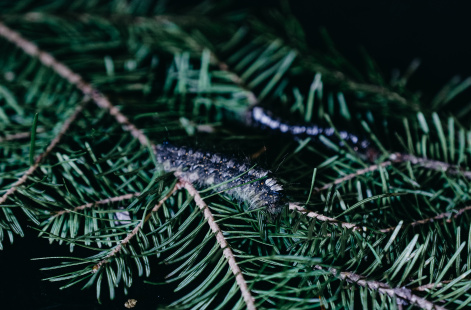Parasitoids will help cope with the pest of coniferous forests - the Siberian silkworm
23 April 2024 г.

The Siberian silkworm is one of the main pests of coniferous forests in the Asian part of Russia. It causes massive death of trees, leading to huge environmental and economic losses. Outbreaks of the Siberian moth can simultaneously cover millions of hectares. Pest control requires significant costs, mainly for treating forests with insecticides using aviation.
Researchers from the Federal Research Center "KSC SB RAS", together with colleagues from other organizations, collected data on the diversity of Siberian silkworm over the past 118 years. Based on these data, the effect of various parasites on the mortality of Siberian moth in North Asia and the possibility of applying the data for biological control of harmful insects were studied.
Parasitoids are organisms that live at the expense of the host during the larvae (feeding) stage. They are known as the main natural enemies of insect pests. Based on archival collections, literature data from North Asia, and their recent field studies in various regions of Siberia and the Far East, the scientists presented data on the diversity of insects parasitizing the Siberian silkworm. A total of 860 parasitoid specimens were analyzed in the study, including 630 freshly collected and 230 archived ones.
To determine their species, scientists used morphological analysis and the DNA barcoding method. Original genetic data were obtained for 11 species of parasitoids from Siberia, which can be used for molecular genetic identification of species.
The most effective parasitoid species for controlling Siberian silkworms were identified in the study. They destroy eggs and caterpillars of the pest, thereby regulating its population. Some species that parasitize silkworm eggs destroy more than 50% of them. Other species lead to the death of up to 70% of the larvae. Siberian silkworm pupae also suffer from parasitoids. Their mortality in some years can reach 90% as a result of the activity of parasitic tachina flies. Scientists note that detailed studies of the potential of parasites are an important task that should be paid close attention to in order to develop effective biocontrol programs for the forest pest of the Siberian silkworm.
“Over the past three years, outbreaks of Siberian silkworms have been recorded in the Irkutsk region, the Republic of Buryatia, the Republic of Sakha and the Altai Region. Their economic and environmental losses are already visible, although they have not reached their peak yet. We have compiled a list of parasitoids associated with the Siberian silkworm in the Asian part of Russia, eastern regions of Kazakhstan, Mongolia, China and Korea. In addition, we have assessed the contribution of some parasitoid species to pest mortality. The study shows that parasitoids play an important role in regulating the number of Siberian moth. This knowledge is extremely important, especially in terms of the risks of the Siberian silkworm spreading to the west. Parasitoids that cause significant death of eggs, caterpillars and pupae of the Siberian silkworm should be further studied to develop effective biocontrol programs,” said Natalya Kirichenko, Doctor of Biological Sciences, leading researcher at the V.N. Sukachev Institute of Forests SB RAS.
The research was supported by the Russian Science Foundation (project No. 22-16-00075).
The study also involved scientists from the Siberian Federal University, All-Russian Plant Quarantine Center, All-Russian Research Institute of Forestry and Forestry Mechanization, Zoological Institute of RAS, All-Russian Research Institute of Plant Protection, Russian Center for Forest Protection, M.V. Lomonosov Moscow State University, Ontario Biodiversity Institute at the University of Guelph (Canada), and Euro-Mediterranean Plant Protection Organization - EPPO (France).
Share:
